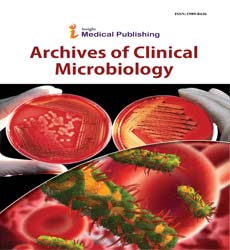Abstract
Preventative and Curative Effect of Moringa oleifera Aqueous Extract to Ensure Safe Natural Antimicrobials Targeting Foodborne Pathogens
The interest in biopreservation of food has prompted the quest for new natural antimicrobial compounds from different origins including plants. Medicinal plants are moving from fringe to mainstream use with a greater number of people seeking for remedies and health approaches from side effects caused by synthetic chemicals. This has aggravated the search for antimicrobials from plants sources. In this study, aqueous extract of Moringa oleifera was screened for antimicrobial activity against five foodborne bacterial isolates (Bacillus cereus, Staphyllococcus aureus, Escherichia coli, Salmonella typhi and Pseudomonas aeruginosa). As well as, against five fungal and yeast strains, including Aspergillus niger, Aspergillus flavus, Penicillium italicum, Rhizopus stolonifer and Candida albicans. Various methods for better antimicrobial activity were established. Minimum Inhibitory Concentration (MIC) and time-kill assays were also determined. The Moringa oleifera aqueous extract exhibited antimicrobial activity towards all tested microorganisms with markedly stronger anti-Gram positive bacteria activities were 26.2 ± 0.55 and 24.26 ± 0.71 (mm) against B. cereus and S. aureus, respectively, while the anti- Gram negative bacteria halos of inhibition ranged from 18.230.81 to 21.73 ± 0.55 as an organism specific. However, the Moringa oleifera aqueous extract showed strong antifungal activity in exception C. albicans, the effect was concentration dependant in a range from 15.2 ± 0.79 to 35.7 ± 0.63. Based on MICs values Moringa oleifera aqueous extract exhibited a wide spectrum of actions against both two Gram-types bacteria and tested fungal/yeast strains and the concentration values ranged from 1.562 to 12.5 mg/ml against bacteria depending on Gram character and ranged from 1.562 to 25 mg/ml against the panel of fungi and yeast tested. The MICs values were organism specific and concentration dependent. Based on the time-kill assay Gram-negative bacteria required longer time of exposure than the Gram-positive one. Interestingly, Moringa oleifera aqueous extract at sub-inhibitory concentrations showed strong activity in smashing up foodborne bacterial biofilm as a dose dependent manner. Scanning Electron Microscopy (SEM) images showed the morphological damages and strong destructive effects against both Gram-positive and Gram-negative bacteria. Finally, Moringa oleifera aqueous extract has good potential for controlling growth of foodborne pathogenic and spoilage microorganisms and open new fields in food biopreservation. As well as, breaks the increasing prevalence of multi-drug resistant strains of bacteria and the recent appearance of strains with reduced susceptibility to antibiotics raised the specter of ‘untreatable’ bacterial infections and adds urgency to the search for new infection-fighting strategies.
Author(s):
Sofy AR, Hmed AA, Sharaf AMA, El-Dougdoug KA
Abstract | Full-Text | PDF
Share this

Abstracted/Indexed in
- Google Scholar
- Open J Gate
- Genamics JournalSeek
- The Global Impact Factor (GIF)
- Open Archive Initiative
- China National Knowledge Infrastructure (CNKI)
- Scimago
- Directory of Research Journal Indexing (DRJI)
- WorldCat
- Proquest Summons
- Publons
- MIAR
- ResearchGate
- University Grants Commission
- Geneva Foundation for Medical Education and Research
- Secret Search Engine Labs
Open Access Journals
- Aquaculture & Veterinary Science
- Chemistry & Chemical Sciences
- Clinical Sciences
- Engineering
- General Science
- Genetics & Molecular Biology
- Health Care & Nursing
- Immunology & Microbiology
- Materials Science
- Mathematics & Physics
- Medical Sciences
- Neurology & Psychiatry
- Oncology & Cancer Science
- Pharmaceutical Sciences

